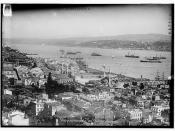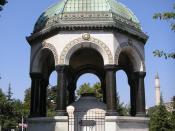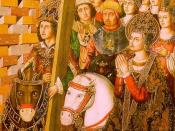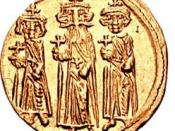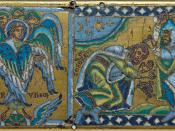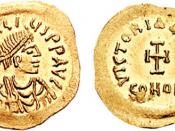Life in Constantinople appeared to center around the Church, the Palace and the Hippodrome. Religion was the fundamental aspect to all facets of life within the capital. Festivals were of a religious nature and even the Emperor held them in the highest of regards1. Events and occurrences were the result of the intervention by their God; even military action now resembled crusades2. Divine supernatural intervention encumbered the theological thoughts of the residence of Constantinople. Visions, signs and amulets were used to predict and subsequently account for the fortunes and misfortunes of the city3. Icons, images and art were a concise reflection of the capitals religious enthusiasm.
The churches in Constantinople embarked on a mission to relay the biblical sagas by pictorial depictions. "Sacred Art" dominated walls within the capital4. Iconography of Jesus, Mary, the apostles and various prophets were mass produced to ensure everyone pious could possess such images.
To further honour the religious figures of their beliefs, the church erected pictures and statues all over Constantinople. Images, which embraced Christianity, were highly important to the pious residence of Constantinople5. Copious amounts of religious paraphernalia adorned the capital and an obvious zeal for religion was a common and fundamental aspect to all who lived in this city.
The Hippodrome was the location in Constantinople where social interaction between its citizens took palace one the grandest scale6. It was the area within the capital were leisure, entertainment and social activities occurred. The activities within the Hippodrome are a reflection of the cultural natural of Constantinople. Likewise, the palace was a center for social activity in the capital7. It would appear that all facets of life, that wasn't domestic, centered around the Cathedrals, Hippodrome or palace.
Life within the capital was cruel and brutal. Even the official punishment system involved server mutilations and public executions entailing torture8. The residence not only lived in fear of the church and cruelty from the government and its fellow citizens, but a constant air of danger from foreign invasion would have blanketed the city9. Constantinople endured siege after siege from foreign armies, interested in capturing the capital. In addition, the knowledge of being prone to earthquakes and other natural disasters would have been present10.
When Heraclius usurped the throne, Byzantine was bankrupt and experiencing one of its darkest periods in its history. Poverty, starvation and high taxes were rampant within Constantinople11. The empire had lost over half of its territory and life would have been extremely bleak in the capital.
The extract from Chronicon Paschale relays an image of life in Constantinople during the time of Heraclius's reign as a period of turmoil. Secular beliefs, continuous war and the subsequent effects of war controlled their lifestyle. Socially, the populace had turned away from education and the arts as bankruptcies, famine and poverty dominated Constantinople12.
1. Chron Pas, Heraclius. Pg: 2. Chron Pas, Heraclius. Pg: 713 (line 6), 716 (line 9-16), 719 (line22), 722 (line 2-5) 3. Chron Pas, Heraclius. Pg: 724 (line 19-20), 725 (line 11), 735 4. Baynes. N. THE BYZANTINE EMPIRE. Pg:178 5. Chron Pas, Heraclius. Pg: 703 (line 13-14), 705 (line 4-11) 6. Chron Pas, Heraclius. Pg: 701 (line 3, 16-18), 703 (line 23) 7. Chron Pas, Heraclius. Pg: 703 (line 1) 8. Chron Pas, Heraclius. Pg: 700 & 701 9. Chron Pas, Heraclius. Pg: 706 (line 11f), 713 (line 1-5), 716 (line 9-15), 717 (line 13-16), 719 (line 7-15) 10. Chron Pas, Heraclius. Pg: 702 (line 9-10) 11. Chron Pas, Heraclius. Pg: 708, 711 (line 14-15) 12. Chron Pas, Heraclius, No mention of education, kiteratur or the arts. Continual mention of religious matters.
REFERENCES.
BAYNES. N. THE BYZANTINE EMPIRE. LONDON, 1925.
CHRONICON PASCHALE: TR. M&M WHITBY. LIVERPOOL UNIVERSITY PRESS, 1989 OSTROGORSKY. G. HISTORY OF THE BYZANTINE STATE. GREAT BRITIAN, 1986.
RODLEY. L. BYZANTINE ART AND ARCHITECTURE: AN INTRODUCTION. LONDON, 1994
